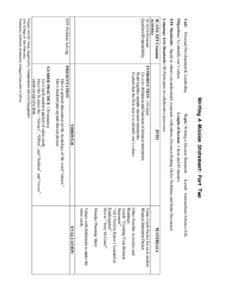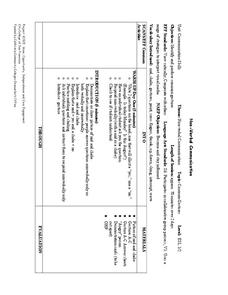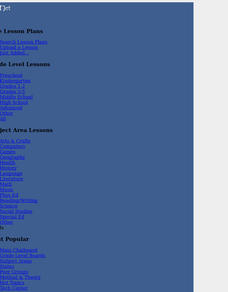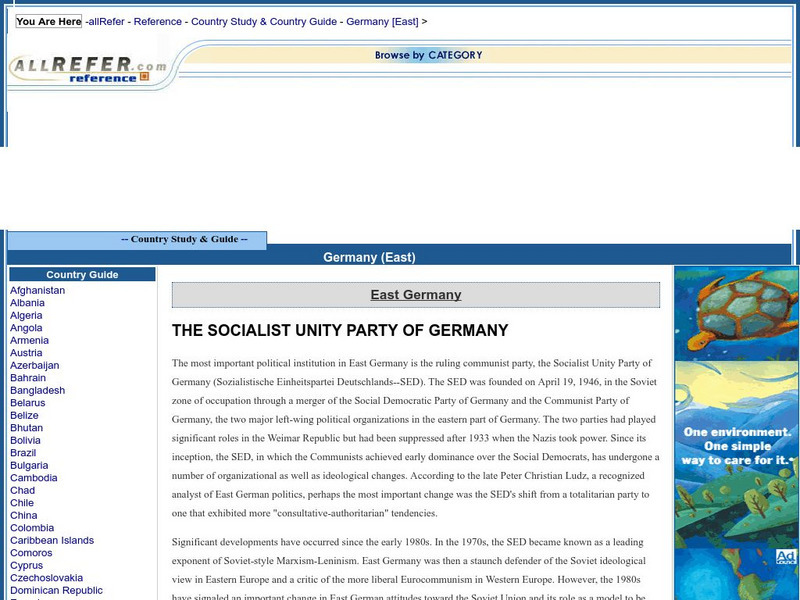Curated OER
Values
Students identify personal values. They construct a Bulls' eye arrow puzzle and write values they stand for on the board. In groups, students construct a collage representing their special interests and values. They share their...
Curated OER
Habits
Students explore and analyze personal positive and negative habits. They read aloud the handout, "Who am I," and discuss what the term habit means and how to relate it to their personal lives. Each student responds on the term in their...
Curated OER
Writing A Mission Statement: Part Two
Student's identify one's values. They go over definition and function of mission statements. Students are explained the first steps in identifying one's values. They discuss the etymology of the word "values." Students pair up and...
Curated OER
Goal Setting
Students practice setting goals that are short and long term. They look at the goals for the cost of resources like time to reach each goal, the pros and cons are then weighed to know the context. Then the students write a reflective...
Curated OER
Non-Verbal Communication
Students investigate the concept of non-verbal communication and how it is conducted in various social contexts. They use pictures in order to see the kinds of emotion that can be expressed with the posture of the body or looks of the face.
Curated OER
Asking Questions
Students investigate the concept of asking questions in order to create ones that are direct and need little clarification. They also develop the skill of forming opinions and expressing ideas. Students practice having a dialogue that is...
Curated OER
The Star-Spangled Banner
Second graders explore American song. In this Star Spangled Banner lesson, 2nd graders discuss what it means the meaning the lyrics of the song and the history behind the song as they participate in a classroom activity.
Curated OER
The Declaration of Independence
Middle schoolers begin their examination of the Declaration of Independence. Using the text, they answer questions for their citizenship interview. They also examine the role of Jefferson in creating the document and how he participated...
Curated OER
Frogs and Toads Are Different
Second graders identify the unique characteristics of frogs and toads. Through Internet research and reading the book Frog and Toad are Friends by Arnold Lobel, 2nd graders compare and contrast the two amphibians.
Curated OER
Little House in the Census: Almanzo and Laura Ingalls Wilder
Learners view copies of the 1880 and 1900 censuses and then create and conduct their own census of their homes, comparing all three.
Curated OER
This Land is Your Land
Students consider the concept of borders and their development by looking at maps and documents. They create a presentation highlighting a current border dispute and propose solutions.
Curated OER
European Union Map Quest
Sixth graders identify countries of the European Union. They locate countries of Europe on a map and pair with a student to complete a blank map of Europe. They label each country and complete worksheets for the European Union. They...
Curated OER
No Path Without Pain
Students analyze the message of John Lennon's "Imagine." In this promoting peace lesson, students complete a cloze activity on the song and discuss its meaning. Students then write their own versions of "Imagine."
Curated OER
Values
Students use MS word to create a two-column table. They use online dictionaries to find the definitions of 34 values. Students identify two values that the student most identifies with. They disucss what the values with one classmate.
Curated OER
"I Statements"
Students identify that "I statements" can be used to accentuate positive behavior or for complements. Students work together to write appropriate "I statements" Students share their group's I-Statements. Students identify and analyze...
Curated OER
Communication
Elicit from the Ss things that people say that bother them when they are having a conversation. For example: When I'm sharing my problem and the other person says, "Well, you know what happened to me?" Ask what is wrong with this...
Curated OER
Kwanzaa Language Arts: The Tambiko
Students read or hear about famous African Americans to learn about the ways in which they exemplify one of the seven principles of Kwanzaa.
Curated OER
Individual Rights And Responsibilities
Students investigate a trial in the netherlands in order to comprehend the concept of human rights and how they need protection. They conduct the research done by reading in small groups and have a mock trial using the details of the...
Curated OER
Defining Ethnic Minorities in China
Ninth graders, in groups, research some of China's 56 identified ethnic groups. They prepare maps and posters to display their research.
AllRefer
All Refer Reference: East Germany: Socialist Unity Party of Germany
This is an informative site that describes the creation of the Socialist Unity Party of Germany. This was essentially the communist party of Eastern Germany after WWII. Traces party history up through the 1980s.
ArtLex
Art Lex: Unity
This site from Artlex provides a brief but effective definition of the Principle of Design known as Unity. There are links to other terms within the definition.
Jim Loy
Jim Loy: Roots of Unity
Contains relevant information regarding to roots of unity and a few examples, including diagrams. Information is helpful and concise.
Other
Blue Moon Original Oil Paintings: The Principle of Unity
Illustrated essay on the principle of unity, also known as harmony, explains how the grouping techniques of alignment, proximity, similarity, and continuity can be used to create a unified, harmonious composition.
AllRefer
All refer.com: East Germany: Postwar Government
This site explains the economic and political developments of the German Democratic Republic (East Germany) after WWII. Contains information on dividing up Germany after WWII, the Soviet zone of occupation, Soviet interests and motives,...
Other popular searches
- Com Unity Helpers
- Com Unity Service Projects
- Com Unity Building
- Com Unity Jobs
- Com Unity Spanish
- Com Unity Festival
- Com Unity Skills
- Com Unity Appreciation
- My Com Unity
- Com Unity Places Pics























